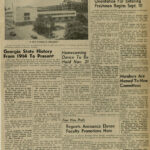The Signal’s Role in Forming Institutional Identity



For much of its early existence, Georgia State lacked a clear, unifying identity. GSU started as night and daytime business classes at Georgia Tech, then was a continuing education unit of the new University System of Georgia, and finally became the Atlanta branch campus of the University of Georgia (UGA). With no charter or founding date, and a history of separate yearbooks, student newspapers, and student governing bodies for the day and night school students, creating a consensus around one unique identity that affirmed our history proved challenging.
Following independence from UGA on September 1, 1955, our newly named “Georgia State College of Business Administration” set out to choose its own mascot and school colors. The Signal student newspaper, one of the earliest and longest continuing University Archives acquisitions, documents this process from students’ point of view and reflects controversy, consensus building, and ongoing changes in our institution’s history. Before social media and the internet, student-run print media uniquely offered an opportunity to publish student voices.
The Night School and the Day School student governments each chose committees to select a mascot and school colors. Selection of a mascot was a relatively easy process. The black and white Penguin was first approved but later reconsidered over “foresight on part of the school’s reputation.” The Panther was then chosen unanimously. The choice of school colors was a long and contentious battle. Signal editorials described the repeated selection of black and white colors (representing the Night and Day Schools) as a “spite vote” and a “hot potato.” With no progress in sight, the Signal urged compromise. Finally, almost a year and a half later, Night School students, Day School students, and the college’s administration all agreed to red and gray as official colors.
The Signal today continues its tradition covering issues that unite, divide, challenge, and inform the university community. For more information on GSU’s history, see our Georgia State University History Timeline.



